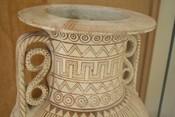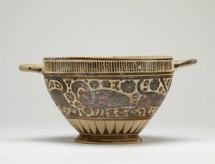Historia Antiqua - Ancient Greek Pottery

Archaeologists are thankful that pottery didn’t have much appeal for treasure hunters throughout history, and
because of its durability a huge amount of Greek pottery has survived for thousands of years. The vast majority
of Greek vases were used in every day life. The clay had a high iron content, which gave it an orange-red color,
and painters and potters often worked together in workshops under the watchful eye of a master potter. Learn
about the decorative styles that evolved over the centuries that gave us a window into the lives of people who left
no written record.
Topic: Classical pottery Language: English Lexile: 1550 http://www.ancient.eu.com

The Walters Art Museum’s online collection of works from ancient Greece represents the world’s most significant collection of artifacts from around the third millennium B.C. through the end of the first century B.C. Among the 100 images, presented in chronological order on this site, are examples of sculptures, statuettes, drinking vessels and other household objects, masks, gemstones, jewels and various types of adornment. Each object is linked to a description containing the physical dimensions, medium, period, artist and place of origin.
Topic: Hellenistic Art, Sculpture Lexile: 1350 Image collection http://art.thewalters.org
Video: Ancient Greek Vase Production and the Black-Figure Technique
The Greeks used vases to store and ship wine, grains, and other goods. The vases were usually decorated with scenes from daily life as well as the tales of the gods and goddesses. The most popular techniques for painting and decorating vases were what’s called the black-figure technique in which the figures were silhouettes in black or the figures were left red, the color of the clay. The black figure technique was developed around 700 B.C., and the red figure technique showed up around 530 B.C. Watch and see how these techniques were used in making a black-figure storage jar.
Topic: Classical pottery Language: English Lexile: 1520 Video http://www.artic.edu
Scenes of Everyday Life in Ancient Greece
Athenian craftsmen developed elaborate styles for painting pottery. Black-figure vase painting depicted scenes of battle or illustrated the tales of legendary heroes. Athenian aristocracy values military valor and athletic victories.Not long afterwards, potters developed the red-figure technique. A brush replaced engravings and allowed more complex and natural poses and expressions. The red-figure technique was more suited to scenes of everyday life. As time went by, these scenes involved more women and heartfelt moments. The background remained the color of the clay in the black-figure technique while the design remained the color of the clay in the red-figure technique.
Topic: Classical pottery Language: English Lexile: 1390 Image collection http://www.metmuseum.org
- EResources
- Ebooks
- Contests and Opportunities
- Faculty Resources
- Library Good Reads
- GradPoint (opens in new window)
- LibGuides
- NHS Library Seminars (opens in new window)
-
Historical Links
- Immigrant Groups in the West
- Immigrant Groups in the West Making the Connections
- Immigration Symbols
- Immigration West
- Industrial Revolution Resources List
- Industrialists
- Korean War
- Legacy of Jim Crow
- The 60's
- Women and the Industrial Revolution
- Working Women and the Industrial Revolution
- Working Women During the Industrial Revolution
- Against Slavery
- Immigration
- Louis Braille An Exceptional Man
- MLA and APA Style Guides
- Norwood High School Home
- Quick reference
- Research & Instruction
- Summer Work
- Textbooks
This site provides information using PDF, visit this link to download the Adobe Acrobat Reader DC software.
